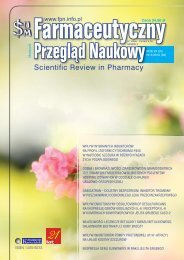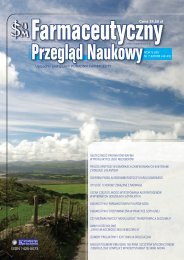Pokaż caÅy numer - FPN - Farmaceutyczny PrzeglÄ d Naukowy
Pokaż caÅy numer - FPN - Farmaceutyczny PrzeglÄ d Naukowy
Pokaż caÅy numer - FPN - Farmaceutyczny PrzeglÄ d Naukowy
You also want an ePaper? Increase the reach of your titles
YUMPU automatically turns print PDFs into web optimized ePapers that Google loves.
copyright © 2010 Grupa dr. A. R. Kwiecińskiego ISSN 1425-5073<br />
aminokwasów lub ich analogów), co potwierdziło znaczenie<br />
obecności związków modyfikujących fazę stacjonarną<br />
układów chromatograficznych w budowaniu modeli analitycznych<br />
interakcji lek-receptor. Na podstawie porównania<br />
użytych układów chromatograficznych stwierdzić można, że<br />
zastosowanie fazy stacjonarnej typu NP TLC i fazy rozwijającej<br />
DS B<br />
prowadziło do uzyskania najlepszych wyników. Było<br />
to prawdopodobnie spowodowane najlepszym dopasowaniem<br />
warunków chromatografii do właściwości lipofilowych<br />
wszystkich badanych związków o różnej budowie.<br />
Przedstawione modele wytypowano na podstawie najkorzystniejszych<br />
wartości współczynnika determinacji R 2<br />
i testów statystycznych (F, p), jako reprezentację każdej<br />
z grup doświadczeń chromatograficznych i rodzaju badanej<br />
aktywności ograniczoną do jednego tylko równania. Są<br />
one propozycją zastosowania konkretnych metod przewidywania<br />
aktywności ligandów receptora 5-HT. Zastosowanie<br />
w analizie przypadków badanych (zw. 1-20) o różnej budowie<br />
potwierdza uniwersalny charakter powstałych modeli.<br />
Badania wykonano w ramach tematu badawczego finansowanego<br />
przez Uniwersytet Medyczny w Łodzi<br />
Nr 502-13-779.<br />
Piśmiennictwo<br />
1. Gaddum JH and Picarelli ZP. Two kinds of tryptamine<br />
receptors. Br J Pharmac Chemother 1957; 12: 323-328.<br />
2. Luo X, Zhang D, Weinstein H. Ligand-induced domain<br />
motion in the activation mechanism of a G-proteincoupled<br />
receptor. Protein Eng 1994; 7: 1441-1448.<br />
3. Zhang D, Weinstein H. Signal transduction by a 5-HT2 receptor:<br />
a mechanistic hypothesis from molecular dynamics<br />
simulations of the three-dimensional model of the receptor<br />
complexed to ligands. J Med Chem 1993; 36: 934-938.<br />
4. Strader CD i wsp. Identification of residues required for<br />
ligand binding to the beta-adrenergic receptor. Proc Natl<br />
Acad Sci U S A 1987; 84: 4384-4388.<br />
5. Strader CD i wsp. Conserved aspartic acid residues<br />
79 and 113 of the beta-adrenergic receptor have different<br />
roles in receptor function. J Biol Chem 1988; 263:<br />
10267-10271.<br />
6. Ho BY i wsp. The role of conserved aspartate and serine<br />
residues in ligand binding and in function of the<br />
5-HT 1A<br />
receptor: A site-directed mutation study. FEBS<br />
Lett 1992; 312: 259-262.<br />
7. Fraser CM i wsp. Site-directed mutagenesis of m1 muscarinic<br />
acetylcholine receptors: conserved aspartic<br />
acids play important roles in receptor function. Mol<br />
Pharmacol 1989; 36: 840-847.<br />
8. Gray TM, Matthews BW. Intrahelical hydrogen bonding<br />
of serine, threonine and cysteine residues within<br />
α-helices and its relevance to membrane-bound proteins.<br />
J Mol Biol 1984; 175: 75-81.<br />
9. Almaula N i wsp. Mapping the binding site pocket<br />
of the serotonin 5-Hydroxytryptamine2A receptor.<br />
Ser3.36(159) provides a second interaction site for the<br />
protonated amine of serotonin but not of lysergic acid<br />
diethylamide or bufotenin. J Biol Chem 1996; 271:<br />
14672-14675.<br />
10. Choudhary MS, Craigo S, Roth BL. A single-point mutation<br />
(Phe 340 Leu 340 ) of a conserved phenylalanine<br />
abolishes 4-[ 125 I]-iodo-(2,5-dimethoxy)phenylisopropylamine<br />
and [ 3 H]mesulergine but not [ 3 H]ketanserin binding<br />
to 5-hydroxytryptamine 2<br />
receptors. Mol Pharmacol<br />
1993; 43: 755-763.<br />
11. Choudhary MS i wsp. Differential ergoline and ergopeptine<br />
binding to 5-hydroxytryptamine 2A<br />
receptors: ergolines<br />
require an aromatic residue at position 340 for high<br />
affinity binding. Mol Pharmacol 1995; 47: 450-457.<br />
12. Edvardsen O, Sylte I, Dahl SG. Molecular dynamics of<br />
serotonin and ritanserin interacting with 5-HT 2<br />
receptor.<br />
Brain Res Mol Brain Res 1992; 14: 166-178.<br />
13. Kristiansen K, Edvardsen O, Dahl SG. Molecular modelling<br />
of ketanserin and its interactions with the 5-HT 2<br />
receptor. Med Chem Res 1993; 3: 370-385.<br />
14. Hibert MF i wsp. Three-dimensional models of neurotransmitter<br />
G-binding protein-coupled receptors. Mol<br />
Pharmacol 1991; 40: 8-15.<br />
15. Kristiansen A , Dahl SG. Molecular modeling of serotonin,<br />
ketanserin, ritanserin and their 5-HT 2c<br />
receptor<br />
interactions. Eur J Pharmacol 1996; 306: 195-210.<br />
16. Boess FG i wsp. Interaction of tryptamine and ergoline<br />
compounds with threonine 196 in the ligand binding site<br />
of the 5-hydroxytryptamine6 receptor. Mol Pharmacol<br />
1997; 52: 515-523.<br />
17. Wesołowska A. In the search for selective ligands of<br />
5-HT 5<br />
,5-HT 6<br />
and 5-HT 7<br />
serotonin receptors. Pol J Pharmacol<br />
2002; 54: 327- 341.<br />
18. Shih JC, Chen KJ-S, Gallaher TK. Molecular biology of<br />
serotonin receptors. Psychopharmacology – The Fourth<br />
Generation of Progress. American College of Neuropsychopharmacology,<br />
2000.<br />
19. Aghajanian GK, Sanders-Bush E. Serotonin. Neuropsychopharmacology:<br />
The Fifth Generation of Progress.<br />
American College of Neuropsychopharmacology, 2002.<br />
20. Spier AD, Lummis SC. The role of tryptophan residues<br />
in the 5-Hydroxytryptamine(3) receptor ligand binding<br />
domain. J Biol Chem 2000; 275: 5620–5625.<br />
21. Muntasir HA i wsp. Identification of a key amino acid of<br />
the human 5-HT2B serotonin receptor important for sarpogrelate<br />
binding. J Pharmacol Sci 2007; 104: 274-277.<br />
22. Braden MR i wsp. Molecular interaction of serotonin<br />
5-HT 2A<br />
receptor residues Phe339 (6.51) and Phe340 (6.52)<br />
with superpotent N-benzyl phenethylamine agonists.<br />
Mol Pharmacol 2006; 70: 1956-1964.<br />
23. Manivet P i wsp. The serotonin binding site of human<br />
and murine 5-HT 2B<br />
receptors. J Biol Chem 2002; 227:<br />
17170-17178.<br />
24. Beene DL i wsp. Tyrosine residues that control binding<br />
and gating in the 5-hydroxytryptamine 3<br />
receptor revealed<br />
by unnatural amino acid mutagenesis. J Neurosci<br />
2004; 24: 9097-9104.<br />
25. Bate-Smith EC, Westall RG. Chromatographic behavior<br />
and chemical structure I. Some naturally occurring phenolic<br />
substances. Biochim Biophys Acta 1950; 4: 427-<br />
440.<br />
26. Afantitis A i wsp. A novel QSAR model for predicting<br />
induction of apoptosis by 4-aryl-4H-chromenes. Bioorg<br />
Med Chem 2006; 14: 6686-6694.<br />
41
















